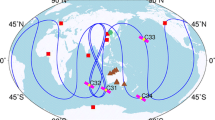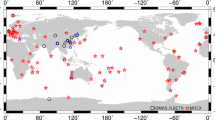Abstract
As of June 2019, 18 BDS-3 medium earth orbit (MEO) satellites have been launched into orbit. We perform precise orbit determination for these BDS-3 satellites with the rate-limited attitude models and the a priori box-wing solar radiation pressure model. The BDS-3 MEO satellites employ continuous yaw-steering attitude mode. By using proper yaw-attitude models during deep eclipse seasons, the orbit overlapping can be reduced by (0.6, 0.5, 0.4) cm for satellites developed by China Academy of Space Technology (CAST) and (0.5, 0.4, 0.3) cm for satellites developed by Shanghai Engineering Center for Microsatellites (SECM) in along-track, cross-track, and radial components, respectively. Compared to nominal attitudes, the attitude models also reduce the RMS of ionospheric-free carrier-phase residuals from 1.87 cm and 1.83 cm to 1.74 cm and 1.79 cm for CAST and SECM satellites in deep eclipse seasons, respectively. In addition, the satellite clock residuals become smoother by using the rate-limited yaw-attitude models. By applying the a priori box-wing SRP model along with a 5-parameter extended CODE orbit model (ECOM1), the orbit overlapping can be reduced to (6.9, 3.8, 1.9) cm for CAST satellites and (10.6, 5.8, 2.4) cm for SECM satellites, which are (0.6, 0.7, 0.6) cm and (0.7, 0.5, 0.7) cm smaller compared to those of the updated ECOM model (ECOM2). The BDS-3 orbits are then validated by satellite laser ranging (SLR), and the results demonstrate mean biases of 0–5 cm with standard derivations of 3–6 cm. The SLR validation also reveals that using an a priori box-wing model can reduce the SLR mean biases and standard deviations when compared to the ECOM2 model.







Similar content being viewed by others
References
Altamimi Z, Rebischung P, Métivier L, Collilieux X (2016) ITRF2014: a new release of the International Terrestrial Reference Frame modeling nonlinear station motions. J Geophys Res Solid Earth 121(8):6109–6131. https://doi.org/10.1002/2016jb013098
Arnold D, Meindl M, Beutler G, Dach R, Schaer S, Lutz S, Prange L, Sósnica K, Mervart L, Jäggi A (2015) CODE’s new solar radiation pressure model for GNSS orbit determination. J Geod 89(8):775–791. https://doi.org/10.1007/s00190-015-0814-4
Bar-Sever Y (1996) A new model for GPS yaw attitude. J Geod 70(11):714–723. https://doi.org/10.1007/bf00867149
Bury G, Zajdel R, Sośnica K (2019) Accounting for perturbing forces acting on Galileo using a box-wing model. GPS Solut 23(3):74. https://doi.org/10.1007/s10291-019-0860-0
CSNO (2017a) BeiDou navigation satellite system signal in space interface control document—open service signal B1C (version 1.0). China Satellite Navigation Office, December 2017
CSNO (2017b) BeiDou navigation satellite system signal in space interface control document—open service signal B2a (version 1.0). China Satellite Navigation Office, December 2017
CSNO (2019a) Satellite antenna phase center of BDS. China Satellite Navigation Office, http://en.beidou.gov.cn/SYSTEMS/Officialdocument/201912/P020200103555670269778.atx
CSNO (2019b) Satellite information of BDS. China Satellite Navigation Office, http://en.beidou.gov.cn/SYSTEMS/Officialdocument/201912/P020200103556125703019.rar
Dai X, Ge M, Lou Y, Shi C, Wickert J, Schuh H (2015) Estimating the yaw-attitude of BDS IGSO and MEO satellites. J Geod 89(10):1005–1018. https://doi.org/10.1007/s00190-015-0829-x
Dilssner F (2010) GPS IIF-1 satellite, antenna phase center and attitude modeling. Inside GNSS 5(6):59–64
Dilssner F (2017) A note on the yaw attitude modeling of BeiDou IGSO-6, a report dated November 20, 2017. http://navigation-ofce.esa.int/attachments_24576369_1_BeiDou_IGSO-6_Yaw_Modeling.pdf
Dilssner F, Springer T, Gienger G, Dow J (2010) The GLONASS-M satellite yaw-attitude model. Adv Space Res 47(1):160–171. https://doi.org/10.1016/j.asr.2010.09.007
EGSC (2017) Galileo satellite metadata. European GNSS Service Centre. https://www.gsc-europa.eu/support-to-developers/galileo-satellite-metadata
Fliegel H, Gallini T, Swift E (1992) Global positioning system radiation force model for geodetic applications. J Geophys Res 97(B1):559–568. https://doi.org/10.1029/91jb02564
He L, Ge M, Wang J, Wickert J, Schuh H (2013) Experimental study on the precise orbit determination of the BeiDou navigation satellite system. Sensors 13(3):2911–2928. https://doi.org/10.3390/s130302911
ILRS (2018) SLRF2014 station coordinates and velocities. International laser ranging service. ftp://cddis.gsfc.nasa.gov/pub/slr/products/resource/SLRF2014_POS+VEL_2030.0_180504.snx
ILRS (2019) ILRS station eccentricities. International laser ranging service. ftp://cddis.gsfc.nasa.gov/pub/reports/slrocc/ecc_une.snx
Jiao W, Ding Q, Li J, Lu X, Feng L, Ma J, Chen G (2011) Monitoring and assessment of GNSS open services. J Navig 64(S1):S19–S29. https://doi.org/10.1017/s0373463311000385
Johnston G, Riddell A, Hausler G (2017) The international GNSS Service. In: Teunissen PJG, Montenbruck O (eds) Springer handbook of global navigation satellite systems. Springer International Publishing, Berlin, pp. 967–982. https://doi.org/10.1007/978-3-319-42928-1
Kouba J (2008) A simplified yaw-attitude model for eclipsing GPS satellites. GPS Solut 13(1):1–12. https://doi.org/10.1007/s10291-008-0092-1
Kouba J (2013) Noon turns for deep eclipsing Block IIF GPS satellites, a note prepared for IGS ACs, dated Dec 19, 2013 [IGS-ACS-930 Mail]
Li X, Ge M, Dai X, Ren X, Fritsche M, Wickert J, Schuh H (2015) Accuracy and reliability of multi-GNSS real-time precise positioning: GPS, GLONASS, BeiDou, and Galileo. J Geod 89(6):607–635. https://doi.org/10.1007/s00190-015-0802-8
Li X, Yuan Y, Zhu Y, Huang J, Wu J, Xiong Y, Zhang X, Li X (2018a) Precise orbit determination for BDS3 experimental satellites using iGMAS and MGEX tracking networks. J Geod 93(1):103–117. https://doi.org/10.1007/s00190-018-1144-0
Li X, Hu X, Guo R, Tang C, Zhou S, Liu S, Chen J (2018b) Orbit and positioning accuracy for new generation BeiDou satellites during the Earth eclipsing period. J Navig 71(5):1069–1087. https://doi.org/10.1017/s0373463318000103
Li X, Yuan Y, Huang J, Zhu Y, Wu J, Xiong Y, Li X, Zhang K (2019) Galileo and QZSS precise orbit and clock determination using new satellite metadata. J Geod 93(8):1123–1136. https://doi.org/10.1007/s00190-019-01230-4
Lu M, Li W, Yao Z, Cui X (2019) Overview of BDS III new signals. Navigation 66(1):19–35. https://doi.org/10.1002/navi.296
Lyard F, Lefevre F, Letellier T, Letellier T, Francis O (2006) Modelling the global ocean tides: modern insights from FES2004. Ocean Dyn 56(5–6):394–415. https://doi.org/10.1007/s10236-006-0086-x
Mendes VB, Pavlis EC (2004) High-accuracy zenith delay prediction at optical wavelengths. Geophys Res Lett. https://doi.org/10.1029/2004gl020308
Montenbruck O, Hauschild A, Steigenberger P (2014) Differential code bias estimation using multi-GNSS observations and global ionosphere maps. Navigation 61(3):191–201. https://doi.org/10.1002/navi.64
Montenbruck O, Schmid R, Mercier F, Steigenberger P, Noll C, Fatkulin R, Kogure S, Ganeshan AS (2015a) GNSS satellite geometry and attitude models. Adv Space Res 56(6):1015–1029. https://doi.org/10.1016/j.asr.2015.06.019
Montenbruck O, Steigenberger P, Hugentobler U (2015b) Enhanced solar radiation pressure modeling for Galileo satellites. J Geod 89(3):283–297. https://doi.org/10.1007/s00190-014-0774-0
Montenbruck O, Steigenberger P, Darugna F (2017a) Semi-analytical solar radiation pressure modeling for QZS-1 orbit-normal and yaw-steering attitude. Adv Space Res 59(8):2088–2100. https://doi.org/10.1016/j.asr.2017.01.036
Montenbruck O et al (2017b) The multi-GNSS experiment (MGEX) of the international GNSS service (IGS)–achievements, prospects and challenges. Adv Space Res 59(7):1671–1697. https://doi.org/10.1016/j.asr.2017.01.011
Pavlis N, Holmes S, Kenyon S, Factor J (2012) The development and evaluation of the earth gravitational model 2008 (EGM2008). J Geophys Res Solid Earth. https://doi.org/10.1029/2011jb008916
Pearlman M, Degnan J, Bosworth J (2002) The international laser ranging service. Adv Space Res 30(2):135–143. https://doi.org/10.1016/s0273-1177(02)00277-6
Petit G, Luzum B (2010) IERS Conventions 2010. No.36 in IERS Technical Note, Verlag des Bundesamtes für Kartographie und Geodäsie, Frankfurt am Main
Rebischung P, Schmid R, Herring T (2016) Upcoming switch to IGS14/igs14.atx. IGSMAIL-7399. https://lists.igs.org/pipermail/igsmail/2016/001233.html
Rodriguez-Solano C, Hugentobler U, Steigenberger P (2012) Adjustable box-wing model for solar radiation pressure impacting GPS satellites. Adv Space Res 49(7):1113–1128. https://doi.org/10.1016/j.asr.2012.01.016
Shi C, Zhao Q, Li M, Tang W, Hu Z, Lou Y, Zhang H, Niu X, Liu J (2012) Precise orbit determination of Beidou satellites with precise positioning. Sci China Earth Sci 55(7):1079–1086. https://doi.org/10.1007/s11430-012-4446-8
Springer T, Beutler G, Rothacher M (1999) A new solar radiation pressure model for GPS satellites. GPS Solut 2(3):50–62. https://doi.org/10.1007/pl00012757
Standish E (1998) JPL planetary and lunar ephemerides DE405/LE405. Interoffice Memorandum IOM 312.F-98-048, Jet Propulsion Laboratory, Pasadena
Steigenberger P, Montenbruck O (2016) Galileo status: orbits, clocks, and positioning. GPS Solut 21(2):319–331. https://doi.org/10.1007/s10291-016-0566-5
Steigenberger P, Hugentobler U, Hauschild A, Montenbruck O (2013) Orbit and clock analysis of compass GEO and IGSO satellites. J Geod 87(6):515–525. https://doi.org/10.1007/s00190-013-0625-4
Tan B, Yuan Y, Wen M, Ning Y, Liu X (2016) Initial results of the precise orbit determination for the new-generation BeiDou satellites (BeiDou-3) based on the iGMAS network. ISPRS Int J Geo Inf 5(11):196. https://doi.org/10.3390/ijgi5110196
Villiger A (2019) IGS14_2056: Update including Beidou-3S and Beidou-3 satellites. IGSMAIL-7782. https://lists.igs.org/pipermail/igsmail/2019/007778.html
Wang C, Guo J, Zhao Q, Liu J (2018) Solar radiation pressure models for BeiDou-3 I2-S satellite: comparison and augmentation. Remote Sens 10(1):118. https://doi.org/10.3390/rs10010118
Wanninger L, Beer S (2015) BeiDou satellite-induced code pseudorange variations: diagnosis and therapy. GPS Solut 19(4):639–648. https://doi.org/10.1007/s10291-014-0423-3
Wu J, Wu S, Hajj G, Bertiger W, Lichten S (1993) Effects on antenna orientation on GPS carrier phase. Manuscr Geod 18(2):91–98
Xia L, Lin B, Liu Y, Xiong S, Bai T (2018) Satellite geometry and attitude mode of MEO satellites of BDS-3 developed by SECM. In: Proceedings of the ION GNSS 2018, Institute of Navigation, Miami, Florida, USA, September 24–28, pp 1268–1289. https://doi.org/10.33012/2018.16118
Xiao W, Liu W, Sun G (2016) Modernization milestone: BeiDou M2-S initial signal analysis. GPS Solut 20(1):125–133. https://doi.org/10.1007/s10291-015-0496-7
Xu X, Wang X, Liu J, Zhao Q (2019) Characteristics of BD3 global service satellites: POD, open service signal and atomic clock performance. Remote Sens 11(13):1559. https://doi.org/10.3390/rs11131559
Yan X, Huang G, Zhang Q, Liu C, Wang L, Qin Z (2018) Early analysis of precise orbit and clock offset determination for the satellites of the global BeiDou-3 system. Adv Space Res 63(3):1270–1279. https://doi.org/10.1016/j.asr.2018.10.038
Yan X, Liu C, Huang G, Zhang Q, Wang L, Qin Z, Xie S (2019) A priori solar radiation pressure model for BeiDou-3 MEO satellites. Remote Sens 11(13):1605. https://doi.org/10.3390/rs11131605
Yang Y, Li J, Xu J, Tang J, Guo H, He H (2011) Contribution of the COMPASS satellite navigation system to global PNT users. China Sci Bull 56(26):2813–2819. https://doi.org/10.1007/s11434-011-4627-4
Yang Y, Tang J, Montenbruck O (2017) Chinese navigation satellite systems. In: Teunissen PJG, Montenbruck O (eds) Springer handbook of global navigation satellite systems. Springer International Publishing, Berlin, pp 273–304. https://doi.org/10.1007/978-3-319-42928-1_10
Zhang X, Li X, Lu C, Wu M, Pan L (2017a) A comprehensive analysis of satellite-induced code bias for BDS-3 satellites and signals. Adv Space Res 63(9):2822–2835. https://doi.org/10.1016/j.asr.2017.11.031
Zhang X, Wu M, Liu W, Li X, Yu S, Lu C, Wickert J (2017b) Initial assessment of the COMPASS/BeiDou-3: new-generation navigation signals. J Geod 91(10):1225–1240. https://doi.org/10.1007/s00190-017-1020-3
Zhang B, Jia X, Sun F, Xiao K, Dai H (2019) Performance of BeiDou-3 satellites: signal quality analysis and precise orbit determination. Adv Space Res 64(3):687–695. https://doi.org/10.1016/j.asr.2019.05.016
Zhao Q, Wang C, Guo J, Wang B, Liu J (2017) Precise orbit and clock determination for BeiDou-3 experimental satellites with yaw attitude analysis. GPS Solut 22(1):4. https://doi.org/10.1007/s10291-017-0673-y
Acknowledgements
We would like to express our gratitude to iGMAS, IGS/MGEX and ILRS for providing GNSS and SLR observation data. This study is financially supported by the National Natural Science Foundation of China (Grant No. 41774030), the Hubei Province Natural Science Foundation of China (Grant No. 2018CFA081) and the National Youth Thousand Talents Program.
Author information
Authors and Affiliations
Corresponding author
Additional information
Publisher's Note
Springer Nature remains neutral with regard to jurisdictional claims in published maps and institutional affiliations.
Rights and permissions
About this article
Cite this article
Li, X., Yuan, Y., Zhu, Y. et al. Improving BDS-3 precise orbit determination for medium earth orbit satellites. GPS Solut 24, 53 (2020). https://doi.org/10.1007/s10291-020-0967-3
Received:
Accepted:
Published:
DOI: https://doi.org/10.1007/s10291-020-0967-3




